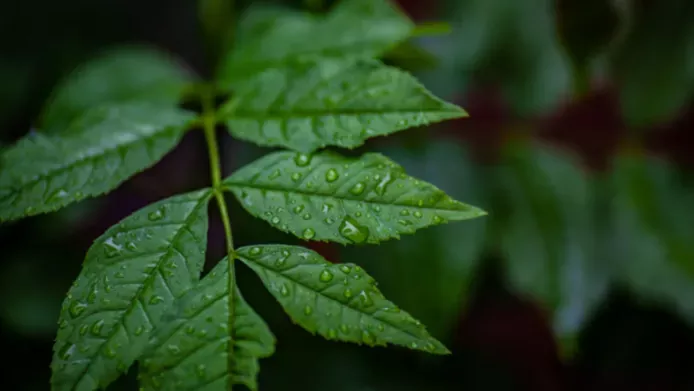Unsung heroes of our urban environments, trees can make all the difference to our collective wellbeing, health, and economic and ecological resilience.
Discover some of the best UK native trees and shrubs to plant in urban spaces.
 Newcastle upon Tyne, UK - City centre planters
Newcastle upon Tyne, UK - City centre planters
Why plant urban trees?
Planting trees in urban areas can greatly benefit communities of people and wildlife. In some urban areas of the UK tree canopy cover is as low as 3%, and planting trees can help tackle the inequity of access to urban greenery.
People in towns and cities all over the UK are doing an amazing amount of planting in their gardens and community areas to help grow our urban forests. However, not everyone has the resources or ability to plant trees.
There are lots of other ways you can help our native plants and wildlife. For a start, why not share a wildlife story you’ve heard with your family or friends or take someone you know on a walk to find a tree in your neighbourhood?
Why UK natives?
To improve plant resilience to diseases and climate change, as well as supporting our wildlife, it is important to plant a range of species.
Many native trees in the UK are resilient because they are well adapted to the climates and growing conditions of local environments.
Because these trees have developed alongside native wildlife, they offer habitats and food for native species that other plants can’t provide, which is why they are invaluable to improving biodiversity in the UK.
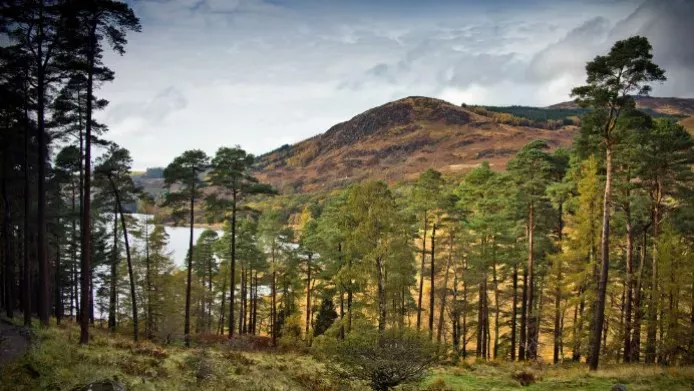
Before you start planting
Before deciding which trees to plant in your local area, there are some important things to consider:
The amount of space
-
Make sure there is enough space for the tree to grow, including branches and underground roots
-
You can check the tree’s label or the RHS website for the dimensions your tree could grow to
Speaking to a local expert
-
In urban environments there can many pre-existing structures and plants, so it's recommended to obtain professional advice and permission from your local tree officer before planting
-
This ensures that trees you are planting won’t negatively affect nearby buildings, plants or wildlife habitats including ponds and flowerbeds
The soil conditions
-
Most urban soils are very different to ‘natural’ soils found in rural areas, due to a build-up of materials caused by humans
-
For example, urban soils could contain higher levels of salt than rural soil due to salt spreading on roads
-
Find out your local soil type, quality and aim for uncompacted soils
-
Seeing what trees and plants thrive in your local area can help to identify soil conditions, e.g. coastal regions often have faster draining soils
-
It is not recommended to apply fertiliser to newly planted trees, as this can encourage competing weeds and grasses to grow
Long-term management
-
Check whether you will need to have the tree you are planting pruned on a regular basis and what this might cost
Trees for planting in small spaces
This could be a smaller garden space, or potentially a potted area.

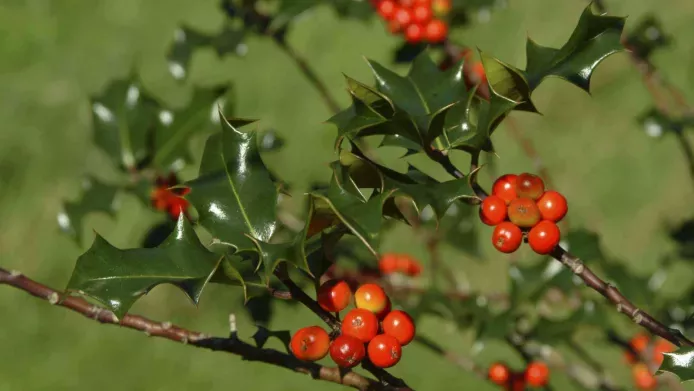
One of our few native evergreens, Common holly is a hardy tree or shrub capable of surviving in most conditions, except where it is extremely wet.
Its distinctive spiny leaves protect birds from predators while they feed on its bright red berries, which appear in late November. The fruit is technically a drupe, and not a berry. Unlike berries, drupes such as holly fruits and plums consist of seeds enclosed in a hard case surrounded by soft flesh.
In May, the white flowers of common holly trees and hedges appear, attracting bees and other insects.
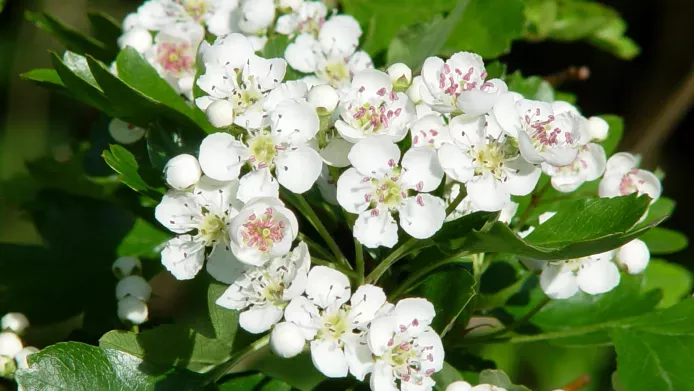
If you want early spring blooms in your neighbourhood, then hawthorn is a must! Hawthorn produces fruit and flowers reliably each year, so is a good choice if you wish to encourage wildlife. It is also low maintenance and easy to keep small.
This tree or shrub is also known as the May Tree or May Flower because it starts blossoming in the UK in May. It has been common in the UK for millennia and steeped in myth. An early pagan symbol of fertility and sexuality, it later became a Christian symbol of chastity.
It often hybridises with the UK’s other native hawthorn, Midland hawthorn (Crataegus laevigata).
Hawthorn will grow in most soil types, in sun or light shade. It is tolerant of exposed sites and urban pollution, so makes a particularly good choice for urban areas.
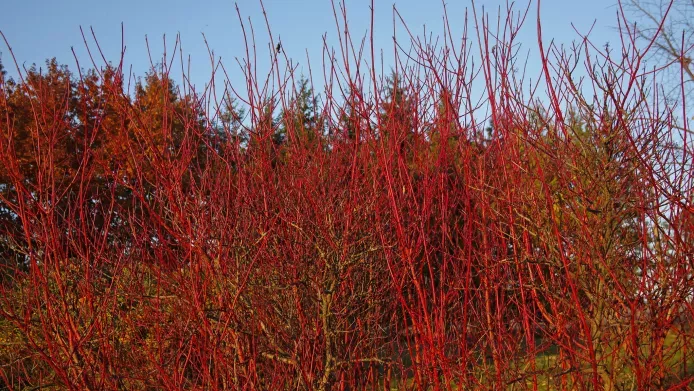
This native plant can be recognised in winter by its distinctive dark red stems. The leaves are oval-shaped, and the white flowers appear in clusters.
It is pollinated by insects, and the leaves and blackish berries provide food for numerous caterpillars, moths, mammals and birds, with birds dispersing the seed far and wide.
Dogwood’s tough branches are very smooth and straight compared to other trees and in the past were used to make arrows and butchers skewers.
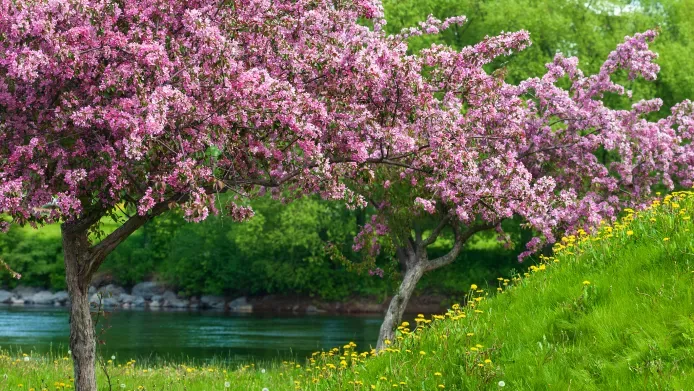
The ancestor of our cultivated apple trees, the scientific name of this wild tree translates to ‘woodland apple’. In spring, its stunning blossoms range from white to deep pink depending on the plant. Crab Apple trees have long been associated with love and fertility.
Like many of our trees, the Crab Apple is an important food source for wildlife, including caterpillars, bees, birds, blackbirds, thrushes and mammals such as mice and voles. The fruit can also be enjoyed by humans by making jellies and wines, however they are generally too tart to be eaten raw.
Trees for planting in large spaces
This could be a large garden, likely an open area or space with fewer buildings and structures.


Scots pine is an evergreen conifer, our only native pine. It grows in the wild in a range of habitats including where there is a deficiency of nutrients in the soil. In Scotland it grows most importantly in the Caledonian Forest, where it supports numerous rare species of plants, insects, and mammals such as the red squirrel.
Scots pine is a low maintenance plant, and it does not need pruning. It is also one of the hardiest plants in the UK, with a Hardiness rating of H7 - hardy in the severest European continental climates (RHS). It can be grown in coastal areas, wildlife gardens and as hedges.

It is thought that this king of the forest can live for over a thousand years.
Large English oak trees are home to an abundance of mosses, ferns, lichens, insects, birds and small mammals. English oaks also have an open leaf canopy, meaning light can filter through to the floor below where flowers such as violets, bluebells and primroses can thrive.
English oaks help many fungi flourish, too - their roots have a symbiotic relationship with fungi such as the orange oak bolete (Leccinum quercinum).
The trees often rely on helpful planters like people, or forgetful squirrels or jays who leave their acorns buried in the ground for a new generation to grow.
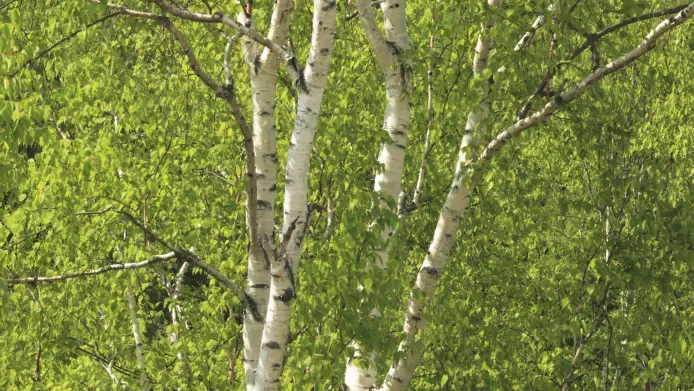
Silver birch trees have grown in the UK since the end of the Ice Age. The species is known as a 'pioneer' species because the trees can easily occupy new ground. Their flowers are wind-pollinated, and they produce an abundance of seeds.
Silver birch trees have a complex relationship with fungi... On the one hand, they don’t often live beyond 70 years old due to suffering attacks from fungi. On the other hand, silver birch trees have a symbiotic relationship with the fly agaric fungus (Amanita muscaria), which helps the tree absorb soil nutrients takes sugars from the tree in return.
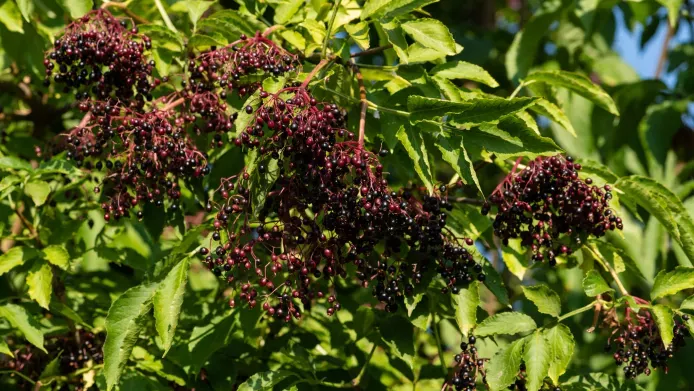
Elder grows quickly in a wide range of habitats. Its flowers attract insects, and its berries provide an important food source for birds such as blackbirds and thrushes.
In the UK the best-known use of elder is in cordials, wines and teas produced from the fruits and berries. The fruit and berries contain low concentrations of toxic chemicals when they are raw, so should be consumed only after cooking.
More about UK native trees

